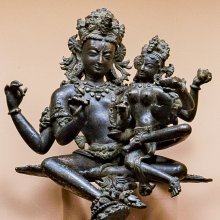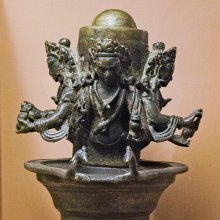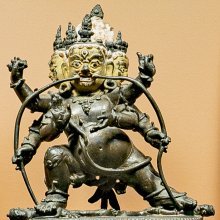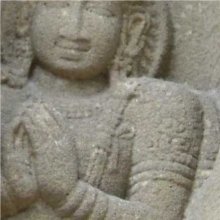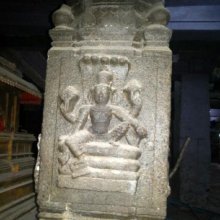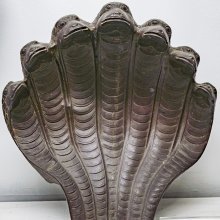Serpent: 4 definitions
Introduction:
Serpent means something in Buddhism, Pali, Hinduism, Sanskrit, the history of ancient India. If you want to know the exact meaning, history, etymology or English translation of this term then check out the descriptions on this page. Add your comment or reference to a book if you want to contribute to this summary article.
Images (photo gallery)
(+42 more images available)
In Hinduism
Natyashastra (theatrics and dramaturgy)
Source: Shodhganga: Elements of Art and Architecture in the Trtiyakhanda of the Visnudharmottarapurana (natya)Serpents (or Snakes) are denoted by the Sanskrit term Uraga, whereas Uragaśīrṣa-hasta refers to one of the twenty-two Single-hand Gestures (in Indian Dramas) (known as asaṃyuktahastas), according to the Viṣṇudharmottarapurāṇa, an ancient Sanskrit text which (being encyclopedic in nature) deals with a variety of cultural topics such as arts, architecture, music, grammar and astronomy.—The name of the uragaśīrṣa-hasta posture itself identifies that the hand posture should look like the head of an uraga i.e., a serpent. In this posture the thumb should be in clinching form and the middle part should remain hollow. According to Abhinavagupta, this posture looks like the head of a snake and that is why this posture is named as uragaśīrṣa.

Natyashastra (नाट्यशास्त्र, nāṭyaśāstra) refers to both the ancient Indian tradition (shastra) of performing arts, (natya—theatrics, drama, dance, music), as well as the name of a Sanskrit work dealing with these subjects. It also teaches the rules for composing Dramatic plays (nataka), construction and performance of Theater, and Poetic works (kavya).
Shilpashastra (iconography)
Source: Shodhganga: Elements of Art and Architecture in the Trtiyakhanda of the Visnudharmottarapurana (shilpa)The Serpent is associated with Nāgas, which follows specific guidelines in the tradition of ancient Indian Painting (citra), according to the Viṣṇudharmottarapurāṇa, an ancient Sanskrit text which (being encyclopedic in nature) deals with a variety of cultural topics such as arts, architecture, music, grammar and astronomy.—The Nāgas are the members of a class of demigods who have the body with half human form and half in serpent’s form. According to the Viṣṇudharmottarapurāṇa, they should have the shape of god and are adorned with snake hood.

Shilpashastra (शिल्पशास्त्र, śilpaśāstra) represents the ancient Indian science (shastra) of creative arts (shilpa) such as sculpture, iconography and painting. Closely related to Vastushastra (architecture), they often share the same literature.
In Buddhism
Tibetan Buddhism (Vajrayana or tantric Buddhism)
Source: academia.edu: The Structure and Meanings of the Heruka MaṇḍalaThe Serpent is associated with the Yoginī (female deity) named Vilāṣī or Vilāsinī, being situated in the Medinīcakra, according to the 10th century Ḍākārṇava-tantra: one of the last Tibetan Tantric scriptures belonging to the Buddhist Saṃvara tradition consisting of 51 chapters.—Accordingly, the medinīcakra refers to one of the three divisions of the dharma-puṭa (‘dharma layer’), situated in the Herukamaṇḍala. The 36 pairs of Ḍākinīs [viz., Vilāṣī or Vilāsinī] and Vīras are yellow in color; the shapes of their faces are in accordance with their names [e.g., Serpent]; they have four arms; they hold a skull bowl, a skull staff, a small drum, and a knife.

Tibetan Buddhism includes schools such as Nyingma, Kadampa, Kagyu and Gelug. Their primary canon of literature is divided in two broad categories: The Kangyur, which consists of Buddha’s words, and the Tengyur, which includes commentaries from various sources. Esotericism and tantra techniques (vajrayāna) are collected indepently.
India history and geography
Source: Singhi Jain Series: Ratnaprabha-suri’s Kuvalayamala-katha (history)Serpents were commonly depicted on the Saṃsāracakra paintings (representing scenes of animal life), in ancient India, as mentioned in the Kathās (narrative poems) such as Uddyotanasūri in his 8th-century Kuvalayamālā (a Prakrit Campū, similar to Kāvya poetry).—Page 185.21 f.: Here follows a description of a printed scroll illustrating the Jaina conception of saṃsāracakra. [...] The saṃsāra-cakra illustrated the three worlds of hell, human world and the world of gods. [For example:] Fight between wild buffaloes; fighting antelopes; a serpent being swallowed by a large monster; [...] peacock swallowing a serpent.

The history of India traces the identification of countries, villages, towns and other regions of India, as well as mythology, zoology, royal dynasties, rulers, tribes, local festivities and traditions and regional languages. Ancient India enjoyed religious freedom and encourages the path of Dharma, a concept common to Buddhism, Hinduism, and Jainism.
See also (Relevant definitions)
Starts with: Serpent cucumber, Serpent garlic, Serpent gourd, Serpent palm, Serpent tree, Serpent-grass, Worship of serpents.
Ends with: Half-serpent.
Full-text (+2400): Naga, Vasuki, Takshaka, Sarpa, Shesha, Kadraveya, Leliha, Shankhapala, Nahusa, Pannaga, Karkotaka, Padma, Ajagara, Bhujaga, Kulika, Sarparaja, Nagin, Nagaloka, Ananta, Mahoraga.
Relevant text
Search found 256 books and stories containing Serpent; (plurals include: Serpents). You can also click to the full overview containing English textual excerpts. Below are direct links for the most relevant articles:
Animal Kingdom (Tiryak) in Epics (by Saranya P.S)
Chapter 6.5 - Astikopakhyana—The narrative of Astika
Chapter 5.6 - The Relations of Nagas With Differnet Deities
The Religion and Philosophy of Tevaram (Thevaram) (by M. A. Dorai Rangaswamy)
Chapter 4.6 - (i) Symbology of the serpent and worship < [Volume 2 - Nampi Arurar and Mythology]
Chapter 4.3 - (e) Arurar’s references to Dance < [Volume 2 - Nampi Arurar and Mythology]
Chapter 60 - Thirukachi Anegathangavatham or Tirukkacci Anekatankavatam (Hymn 10) < [Volume 3.5 - Pilgrim’s progress: to the North]
Kuntaka’s evaluation of Sanskrit literature (by Nikitha. M)
7. Nāgānanda in Kuntaka’s treatment < [Chapter 4 - Kuntaka’s evaluation of Sanskrit Plays of other Poets]
2. Sūktimuktāvalī in Kuntaka’s treatment < [Chapter 5 - Kuntaka’s Evaluation of some Stray Verses]
3.8 (f): Compositional figurativeness or prabandha-vakratā < [Chapter 1 - Vakroktijīvita: A Synoptic Survey]
Kathasaritsagara (the Ocean of Story) (by Somadeva)
Note on serpent-worship < [Notes]
Part 2 - Northern and Central India < [Appendix 8.2 - The Romance of Betel-Chewing]
Vetāla 16: The Sacrifice of Jīmūtavāhana < [Appendix 6.1 - The Twenty-five Tales of a Vetāla]
The Brahma Purana (by G. P. Bhatt)
Chapter 77 - Suppression of Kāliya
Chapter 97 - Uṣā and Aniruddha were brought back
The Skanda Purana (by G. V. Tagare)
Chapter 10 - Karkoṭeśvara (karkoṭa) or Karkoṭakeśvara (karkoṭaka-īśvara-liṅga) < [Section 2 - Caturaśīti-liṅga-māhātmya]
Chapter 114 - The Term ‘Nāgara’ < [Section 1 - Tīrtha-māhātmya]
Chapter 183 - Creation of Nāga Tīrtha < [Section 1 - Tīrtha-māhātmya]
Related products
